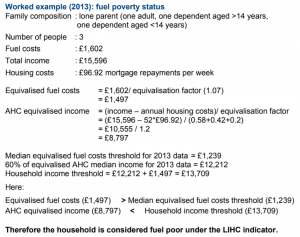Fuel poverty indicator letting down poorer households
Helen Poulter, 23rd Novermber 2018
Now we are in autumn, with winter and Christmas fast approaching, it’s time to batten down the hatches and keep warm and snug in our homes. A lovely time of year for some but not necessarily for those on a low income. Shorter days and lower temperatures mean increased energy costs. There are 3.5 million (12.9%) households in the UK affected by fuel poverty. The purpose of this blog is to show that the current way of assessing the fuel poor via averaged annual bills and income is likely to reduce the numbers of people who are living in fuel poverty at certain times of the year. Moreover, this annual assessment may well lead to those people missing out from being eligible for the limited schemes available .
Calculation
Methods for calculating fuel poverty use a Low Income High Costs (LIHC) model. The LIHC is based on annual household income, area energy prices and energy requirements of properties. Surveys are conducted by an interview with the householder (around 13,000 households) and follow-up physical inspections are taken of around half the dwellings interviewed. The interview and inspection are the basis for estimating household energy costs for different types of properties.
The fuel poverty statistics are based on household income after housing costs (AHC) in relation to the energy costs. Household income includes all household members personal income plus any private source income, state benefits or savings. The AHC is the income left after mortgage or rent payments have been deducted and an equivalisation factor has been applied. The equivalisation factor is a number based on household variables such as if the property is considered to be under occupied, the number of occupants, whether the dwelling needs all day heating etc. The equivalisation factor does not take into account the method of payment. The fuel costs also have an equivalised factor, although a different number than that of the AHC. The fuel costs and the AHC are then divided by the equivalisation factors to reflect the different spending requirements of different households (see figure below for worked example).
When calculating fuel poverty of a household, the median equivalised fuel costs threshold is set at a level; if the household fuel cost is higher than this then that household is rated as HC or higher cost. If the AHC equivalised income of a household is less than the Household Income Threshold , also set at a particular level, then the household is rated in the Low Income (LI) section of the indicator. So if a household is both LI and HC, it is then considered to be fuel poor.
Fuel poverty is when the household has fuel costs that are above the national average, and if they were to spend that amount, their residual income would leave them below the official poverty line. The fuel poverty gap is defined as ‘the amount by which the assessed energy requirements of fuel poor households exceed the threshold for reasonable costs’.

source: BEIS Fuel Poverty Methodology Handbook
There are 3.6 million electricity customers and 2.3 million gas customers using prepayment meters in the UK. There are various reasons why households have a prepayment meter (i) to reduce bill shock, (ii) the household has a poor credit rating or (iii) to pay off a previous debt. A report by Sustainability First states that 52% of prepayment meters are used by vulnerable households. Of that figure 30% are single parent families, the unemployed and people with a long-term illness or disability. 25% of prepayment meter users are currently fuel poor.
The figures for the fuel poverty datasets are annual i.e. annual energy costs, annual earnings. This means that that the energy costs are proportioned equally over a year. However, not all households pay for their energy in equal payments – indeed doing so when you are a low income family or household would require great discipline and may well be impossible given circumstances which arise. For any households, paying for energy in winter can be three times higher as a proportion of income than in summer.
Using myself as an example: I live in a rural area with no access to gas, my house is well insulated and heated with an air-source heat pump (EPC C rating). In the summer my weekly electricity bill is £10-12, as temperatures drop this can be as high as £35-40 per week. This example shows that it is easy for household energy costs to triple over the winter months. For households, who struggle in the summer to pay all their household bills, this increase in the colder months means already poorer households are having to make choices between energy, food, rent and other household bills. If the fuel poverty calculation was taken on a weekly or monthly basis, particularly over the colder months, there would be more granularity of understanding thereby enabling better policies to benefit those in need.
There are schemes available (the Winter Fuel Payment and the Warm Home Discount Scheme) to help vulnerable customers. The Winter Fuel Payment is an automatic, non means tested, lump sum paid to anyone of retirement age. The Warm Home Discount Scheme has to be applied for and is paid for by an energy retailer which is part of the scheme. Eligibility for a Warm Home Discount is dependent on the particular retailer’s criteria. The criteria can vary from only those in receipt of Pension Credit to also include low income families with a large heating requirement.
For those households who pay by prepayment meter and are on the fuel poverty threshold, unless they are of pensionable age, they are unlikely to qualify for the government schemes.
In theory, it is possible for those on prepayment meters to top-up extra amounts in the summer so that they only pay equal amounts through the year. But as said above, this requires huge amounts of discipline for families or households that are only just getting by – and assumes no special circumstances which make a call on that money.
If the fuel poverty calculation was taken for the winter months rather than annually it is likely that many more households would be classed as fuel poor yet currently do not qualify for any help. To have a non-means tested benefit for some while other households struggle and have to make choices between food and fuel seems unfair. It would be more beneficial to have a means tested Winter Fuel Payment available for any age group that recognises the difficulties that paying weekly winter energy bills can cause.
Related Posts
« Previous Global Insights: 20th November 2018 Context and Agenda for Roundtable Next »







